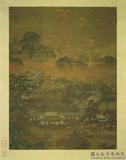明商喜戲貓圖 軸
推薦分享
資源連結
連結到原始資料 (您即將開啟新視窗離開本站)後設資料
- 資料識別:
- 故畫002125N000000000
- 資料類型:
- 類型:繪畫
- 型式:靜態圖像
- 著作者:
- 商喜
- 主題與關鍵字:
- 海棠(草)秋海棠 貓(貍奴) 蝶蛾 蟋蟀 蜂 螞蟻
- 出版者:
- 數位化執行單位:國立故宮博物院
- 格式:
- 本幅 48.2x66.4公分、全幅 69公分
- 關聯:
- 石渠寶笈初編(養心殿),上冊,頁651&*故宮書畫錄(卷八),第四冊,頁75&*故宮書畫圖錄,第六冊,頁173-174&*商喜(約西元十五世紀中期),濮陽人,字惟吉。宣德間,授錦衣衛指揮。善畫虎,得其勇猛之勢。山水人物花鳥,全摹宋人,筆意無不臻妙。 樹陰下草地上,死去的草蟲,螞蟻正趕著搬食,而兩頭貓兒,動作更快;其中一隻已抓著一隻螻蛄。另外一隻,眼睛正大大的瞪著要撲上去。這種題材,極為少見。正足以題示畫家觀察入微,隨處皆可入畫。畫中螞蟻,畫來生動,密密麻麻之感覺油然興起。 &* Shang Hsi was a native of P’u-yang, Hopei province. His style name was Wei-chi. During the Hsüan-te period (1426-1436) he served as an official in the Imperial guard. He excelled at painting tigers and was able to capture their fierce nature. Executed with excellent brushwork, his landscapes, figures, birds and flowers were modelled after Sung masters. On the grass under the shade of an old tree acurry to and fro swarms of ants. They are assiduously at the task of trying to trg away two dead insects. Meanwhile, two cat a have been much quicker than the ants: one has a dead mole cricket in its paw and another with a vigilant hostility is about to strike at one of the ants’ preys. As this motif is exceptionally uncommon, this painting reveals not only Shang’s keen observation of nature but also his alacrity to utilize whatever a good subject matter. In the painting, ants are rendered so lifelike that they rouse a sense of creepiness. &*1.王耀庭,〈商喜戲貓圖〉,收入國立故宮博物院編輯委員會編,《草蟲畫特展圖錄》(臺北:國立故宮博物院,1986年初版),頁69。
- 管理權:
- 國立故宮博物院
授權聯絡窗口
- 國立故宮博物院圖像授權、出版授權、影音資料授權-申請流程說明
http://www.npm.gov.tw/zh-TW/Article.aspx?sNo=03003061






